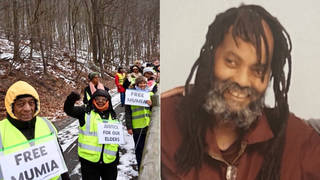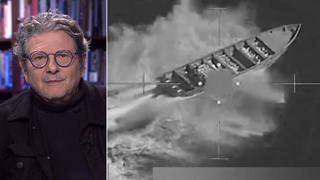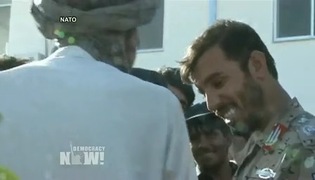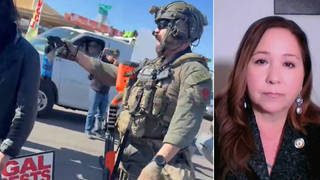
Guests
- Tina FosterExecutive Director of the International Justice Network and the spokesperson for Aafia Siddiqui’s family.
- Petra Bartosiewiczindependent journalist who wrote about Aafia Siddiqui in the November 2009 edition of Harper’s Magazine and covered the trial with daily dispatches for the website Cage Prisoners. She is also working on a book titled The Best Terrorists We Could Find, an investigation of terrorism trials in the US since 9/11.
A New York jury has convicted the US-educated Pakistani neuroscientist Aafia Siddiqui of attempted murder for shooting at US forces while jailed in Afghanistan in 2008. None of the Americans were injured, but Siddiqui was shot and wounded while in US custody. Human rights groups have long alleged that Siddiqui was forcibly disappeared by Pakistani authorities in 2003 and interrogated and tortured at the behest of the United States. In her testimony, Siddiqui claimed to have been held in a US secret prison. We speak to Siddiqui family spokesperson Tina Foster of the International Justice Network and Petra Bartosiewicz, an independent journalist who has been closely following Siddiqui’s case. [includes rush transcript]
Transcript
JUAN GONZALEZ: We begin today with one of the most baffling cases in the so-called war on terror, the story of thirty-seven-year-old Aafia Siddiqui.
On Wednesday, a New York court convicted the American-educated Pakistani neuroscientist of attempted murder for shooting at US soldiers and FBI agents while detained in Afghanistan in 2008.
Back in 2003, Aafia Siddiqui was wanted by law enforcement and the FBI and suspected of links to al-Qaeda leadership. But the MIT-trained scientist had mysteriously disappeared along with her three children, two of whom are US citizens. She reappeared five years later in Afghanistan with her oldest son and was arrested on suspicion of carrying chemicals and notes referring to “mass-casualty attacks” in New York.
Aafia Siddiqui was not tried on terrorism charges or for her alleged ties to al-Qaeda. The case against her rested on events that took place the day after she was arrested in Afghanistan in July of 2008. The prosecution said she grabbed an unattended rifle and opened fire on a group of US soldiers and FBI agents who were questioning her. None of the Americans was injured, but Siddiqui was shot and wounded while in US custody.
AMY GOODMAN: Well, on Wednesday, the jury reached a unanimous verdict, finding Siddiqui guilty of attempted murder, armed assault, and using and carrying a firearm. She faces a maximum sentence of life in prison. Defense lawyers argued there was no physical evidence that Siddiqui had touched the rifle.
ELAINE SHARP: I disagree with the jury’s verdict. In my opinion, it is wrong. There was no forensic evidence, and the witness testimony was divergent, to say the least. This is not a just and right verdict. It is a just and right system, but the jury — juries do make mistakes. Juries do go wrong. And my opinion is that this was a verdict that was based on fear and not fact.
AMY GOODMAN: Meanwhile, human rights groups have long alleged that Siddiqui was forcibly disappeared by Pakistani authorities in 2003 and interrogated and tortured at the behest of the United States. In her testimony last week, Siddiqui claimed to have been held in a secret prison by the Americans.
For more on the case of Aafia Siddiqui, we’re joined here by two guests. Tina Foster is the executive director of the International Justice Network. She’s a spokesperson for Aafia Siddiqui’s family. Petra Bartosiewicz is an independent journalist who has been closely following this story. She wrote about Aafia Siddiqui in the November issue of Harper’s Magazine, the piece called “The Intelligence Factory: How America Makes Its Enemies Disappear.” She’s working on a book called The Best Terrorists We Could Find, an investigation of terrorism trials in the US since 9/11.
We welcome you both to Democracy Now! Tina, let’s begin with you. Your response to the verdict?
TINA FOSTER: Well, the family’s response obviously is one of great disappointment, but I can’t say a great deal of shock, because from the beginning of this trial, Dr. Aafia Siddiqui was portrayed as a terrorist, and instead of assuming the presumption of innocence, which most criminal defendants get when they come into a courtroom, Dr. Aafia had already been painted very much as a dangerous woman before she was even brought into the courtroom. And so, I think we saw during the course of the trial that she suffered the prejudice that was — that had already been laid as a foundation.
So, the family is going to obviously be calling for an appeal. We’re obviously most concerned about Aafia’s mental state, because during the trial, she clearly was not herself. She made a number of outbursts during the trial, and we think that is directly related to the trauma that she suffered while in secret prisons and while tortured for those five years while she was missing. In addition, she’s been in solitary confinement for a year and a half while in US custody. That has also contributed to her deteriorating mental state.
And probably perhaps most importantly, why my organization became involved in this case is the two children, the two youngest children of Dr. Aafia, who were three months old and four years old when they were captured, are still missing. And the International Justice Network believes that those children were also taken into detention at the same time that Aafia was, and we’re still looking for those two children.
JUAN GONZALEZ: And the decision of the government, even though the alleged crime that she was on trial for happened in Afghanistan, to have the trial here in New York, what was the basis for that?
TINA FOSTER: Well, I mean, I think that this is a pattern that we’ve seen actually since 9/11 of individuals who should probably stay in the criminal justice systems of the places where they are detained being shifted around in sort of a shell game. I think Aafia Siddiqui was likely in a number of secret prisons in Pakistan, in Afghanistan, before she came to be in US custody.
When she came into US custody, the first that we had heard from the family, after five years of her disappearance, was that she had — she was at Bagram Hospital in US custody, and she had been shot several times. And the explanation that was given were the facts that were alleged in the shooting.
AMY GOODMAN: Petra Bartosiewicz, let’s go back to the beginning. You wrote this very interesting story in Harper’s Magazine about Aafia. Tell us how you got interested, and then tell us her story from the beginning, this MIT-trained neuroscientist. What happened to her?
PETRA BARTOSIEWICZ: Well, I first heard about the case in August 2008, when she was brought to the United States from Afghanistan. And as Tina was saying, the issue of why she was brought here, she was entitled to a consular visit in Afghanistan, which she didn’t receive.
And the jury was told that she was brought to the United States to face charges because she opened fire on US soldiers, and that was the justification. But what the jury didn’t hear is this huge back story in this case, which kind of gives it the all-important context, and I think the trial sort of happened in a vacuum where it was just about this shooting in a room. But what they were not told was that she’d been missing for five years and that when she went missing in 2003, she was a suspected al-Qaeda operative. And she was never charged with that in this case.
AMY GOODMAN: When you say she went missing, where was she?
PETRA BARTOSIEWICZ: Well, she went missing from Karachi, Pakistan. That’s most of the reports. She actually spent about eleven years in the United States. She was educated in the US. She came to the US from Pakistan, and she joined her brother in Houston. He lives in Houston now. And she studied at MIT and Brandeis. And two of her three children were born in the US. She was married in the US to a Pakistani man.
And she lived a normal life until just after 9/11, when there were some reports that brought mainly her husband, I think, at the time, under suspicion. And they were interviewed by the FBI, and nothing really came of it. She eventually returned to Pakistan. She divorced. And then, in 2003, she went missing. But right around the time she went missing, there were increasing reports that she was wanted for questioning. And then later she was named an al-Qaeda — suspected al-Qaeda operative. But for five years, no one heard anything about her.
JUAN GONZALEZ: Well, in your efforts to get to the back story, as you say, you traveled all over Pakistan. She comes from a very prominent family, you suggested in the article, and you interviewed several of the relatives. And generally the press accounts there assumed she was in CIA or US custody during all that time?
PETRA BARTOSIEWICZ: Yes, I think the main — the story that most people believe in Pakistan is that she was picked up, but by Pakistanis. I think the conventional wisdom is that the US intelligence community relies on the Pakistani intelligence community very heavily, and so the belief is that she would have been picked up by the Pakistanis. And my reporting suggested that, as well, and that she was either handed over to the CIA immediately or soon after or at some point.
Some people are held in what is called custodial — in a custodial situation, where the Pakistanis might have control over them physically, but the US has access to question them. There are numerous documented accounts of that. And the belief was, though, that she was picked up. Now, there are also reports that she was on the run for some period of time, but it does seem that she was held somewhere for some period of this time.
AMY GOODMAN: The title of your article, “The Intelligence Factory: How America Makes Its Enemies Disappear,” what do you mean by that?
PETRA BARTOSIEWICZ: Well, the war on terrorism is fought largely through intelligence gathering, not really evidence building as in a crime like a murder, for example, where you’re going back after the fact. Terrorism is fought mainly in terms of future: what is going to happen, who might do something, what might they do. And intelligence is sort of the fodder for these investigations.
But intelligence is primarily produced by detainees. And so, we sort of are in this position now where we are needing to produce more and more detainees, who then produce that intelligence. And because we now have all of these confirmed reports about the types of interrogations that are happening, we know that there’s a lot of false intelligence being generated. And that leads to other people being detained. And I think the main tool that investigators use these days is kind of associations, who knows whom, and that’s the primary connection that gets people on the radar. The question of what that relationship actually means, which is all-important, is less investigated.
JUAN GONZALEZ: Tina Foster, I’d like to ask you about the trial itself, though. I guess the most dramatic moment is when she gets on the stand and says that she was being tortured while in US custody. She went on the stand against the advice of her lawyers. She appeared to have a very contentious relationship with the lawyers, claiming that they didn’t represent her. Could you talk about that whole aspect?
TINA FOSTER: Sure, sure. You know, Aafia, when she was brought to the United States in July of 2008, August 2008, she was assigned lawyers, but there was a period of time when she did not have anyone assigned to her. The government of Pakistan stepped in and hired defense lawyers, who were considered a legal dream team at the time. But by the time that had happened, Dr. Aafia had already lost complete faith in the US justice system. She did not trust any court-appointed lawyers, any lawyers that were going to be assigned to her, and she insisted that she wanted to at least have access to a phone book so she could try to find her own lawyers. That was denied by the judge. The judge said, “Listen, there’s a lot of lawyers sitting right here. We’re ready to try this case, and I’m not going to give you more time to go find your own lawyer.” That, I think, set the stage for a very contentious relationship, where Aafia, you know, continually disavowed her lawyers, did not — was not allowed to maintain any sort of relationship with them, and, I think, ultimately was denied effective assistance of counsel as a result of that, not by any mistake the lawyers made, but that was the judge’s call at the time.
When she took the stand, against the advice of her attorneys, she clearly had a story she wanted to tell. And she had not been able to tell it during the trial. She did her best to stay, you know, within the judge’s parameters of what she was allowed to talk about, because, of course, he wouldn’t — though he allowed all of the evidence against her trying to portray her as a dangerous terrorist, he did not allow the defense to broach that area. So, she came across, as Petra said, you know, speaking in a vacuum, and the jury didn’t hear the back story. So she may have appeared a little bit irrational in their minds, because they hadn’t heard that the reason she didn’t know that the boy that was found with her was her son is because they had been separated five or six years ago, and she had not been allowed to see him. So, a lot of the things she said seemed shocking to the jury.
AMY GOODMAN: Tina, can you explain how Aafia resurfaced in Ghazni in 2008?
PETRA BARTOSIEWICZ: Well —-
AMY GOODMAN: Petra.
PETRA BARTOSIEWICZ: She was found in Ghazni with a boy, who turned out to be her son, and she was suspected of being a suicide bomber. She was really just wandering around in the city of Ghazni. And she was said to have on her a slew of documents and some chemical substances, which I think some were just cosmetics. There were some chemicals also. But they were sort of bizarrely incriminating, almost you would write into a movie script. They had words like “mass-casualty attack” and “cells” and named landmarks in New York City, and there were pictures of guns, which, when we saw them in the courtroom, were sort of like something that a child would really draw. They were described as a match gun that could be lit with a single match, and really not the kind of thing that I would expect a seasoned al-Qaeda operative to have with her if she was wandering around.
She turned out not to be a suicide bomber. But she was arrested, supposedly with these documents, and she was taken to an Afghan -— to a local police station. And she was — according to Afghan police who testified at the trial, she was beaten the night that she was arrested by numerous people. I think she was also caned. She was tied to a bed to restrain her. Later she was released from the bed, and she was in a room that was divided by a curtain. It was a very small room. She was behind this curtain. And that’s where she was when this shooting incident occurred.
A US team had been alerted to her presence. FBI officials were called in from another base in Afghanistan. They flew in the following morning to identify her and to interrogate her and also to take her with them. That was the goal. But they were told by the Afghans that they could not do that, that they could question her, but they would not be allowed to take her. And they were ushered into this room on the second floor of the police station, where she was behind that curtain, unbeknownst to them, they say. And Afghan officials were already there, some people from the Ministry of Interior and some soldiers from the police station. And that is when this shooting supposedly took place.
JUAN GONZALEZ: And then I think you also mentioned in your article that, again, another bizarre aspect of this very bizarre case is that she somehow — that there was a rifle that just happened to be on the floor near her, even though she was a suspected connected —-
AMY GOODMAN: Lady al-Qaeda?
JUAN GONZALEZ: Lady al-Qaeda, and they just happened to leave a rifle that she managed to grab and then attempt to shoot some of the agents.
PETRA BARTOSIEWICZ: Well, this is the most disputed part of this case, which is what happened after those US soldiers and FBI agents entered that room. What is agreed upon is that they were all there. She, herself, testified that she moved towards the curtain to peek out to see who was there, and she intended to try to escape. She wanted to get out of there. That’s what she told the jury.
Now, what happened next is the big question. According to the testimony of the US team, which was the soldiers and the FBI agents, they say that a warrant officer, who brought his M-4 automatic rifle with him, set it down near the curtain and that she somehow reached past the curtain, grabbed the gun, and aimed it at them, and actually got two shots off. And there were differences in the eyewitness testimony. Some of the people said they didn’t see the shooting. Some said that they saw her shooting from one of the beds that was in the back of the room. Some said she was next to the bed. There were all sorts of different versions of how this happened. The room was quite small and quite crowded, so people had different vantage points.
But what’s interesting is that there was no forensic evidence whatsoever that she shot that gun. There were no fingerprints on the gun. There were no bullet holes in the walls. There were no casings on the floor. There was an abundance of evidence that she had been shot. They found the casings from the revolver that shot her. They found -— she was obviously wounded, so that was very clear.
I think that clearly what happened in — to a certain degree, is that the people in that room were startled when they saw her. And what happened next —-
AMY GOODMAN: Well, let me ask something about the coverage of the trial, Petra -— the reporters, Pakistani reporters, not being allowed in. Can you explain who covered the trial and why some weren’t in?
PETRA BARTOSIEWICZ: Well, the — before the trial actually started, there was an enormous amount of attention on this case for years, and has been, in Pakistan and much of the Muslim world. And a lot of the Pakistani press came to New York City to cover the trial on a day-to-day basis. But the only credentials that were issued for the courtroom itself were for journalists who have an NYPD press pass, which is actually difficult to get, and it’s meant mainly for crime scene reporters. I don’t have that kind of pass, either. A lot of courthouse reporters don’t have that pass. But that meant that the press rows were reserved only for those people.
And there were about thirty journalists who were credentialed, but they were mainly, you know, the New York City dailies, television stations, radio stations. And most of those outlets don’t cover these kinds of trials from the beginning to the end. They’re there for the first day; they’re there for the last day. And in between, the press rows were very empty.
And the first day, there were only six spaces for public seating, so everybody else was put into an overflow courtroom where they watched the proceedings on a television set. But that meant that whenever exhibits were put on the overhead projector, we couldn’t see that. Some of the witnesses came down off the stand to testify in front of the jury to look at some actual drawings and sketches of the room. We couldn’t really even hear them when they testified on that.
So there was a limited amount of ability to get to the courtroom. The press was — I have to say, the Pakistani press was eventually let into the courtroom, because I think the judge realized that there were not many people covering the case inside the courtroom, but they never really received the actual credentials that would give them that right to be there every day.
AMY GOODMAN: What has changed in covering — in dealing with terror suspects, from Bush to Obama, Tina Foster?
TINA FOSTER: Surprisingly little, unfortunately, I think. You know, in terms of the challenges that are faced by this country in repairing its image internationally, I think that President Obama has done a much better job in terms of articulating the — you know, a more neutral, friendly, positive approach. However, for those of us like myself at the International Justice Network who have been working on secret prisoner cases, people detained at Bagram instead of Guantánamo, all of these issues are a repeat, unfortunately, of what we saw under the Bush administration. So I think that this trial, in particular, of Aafia Siddiqui is one that is going to be watched in Pakistan quite — it’s already of monumental significance in Pakistan.
JUAN GONZALEZ: And she faces now a possible life-in-prison sentence?
TINA FOSTER: Yeah, she faces a potential life sentence. The sentencing won’t happen for several months. But in the interim, you know, we see that the Pakistani media and community are extremely upset, and they think that this is a travesty of justice, because, of course, they have seen the six years of back story and have been following this from the beginning, and they view Dr. Aafia as a torture victim, as someone who symbolizes the hundreds, if not thousands, of people who’ve disappeared as part of the US-led war on terror.
AMY GOODMAN: Well, we will leave it there now, though we will continue to follow the case. Tina Foster, executive director of the International Justice Network, spokesperson for Aafia Siddiqui’s family. And thank you very much to Petra Bartosiewicz, who is an independent journalist closely following Aafia Siddiqui’s case. We will link to her piece at Harper’s called “The Intelligence Factory: How America Makes Its Enemies Disappear.”













Media Options